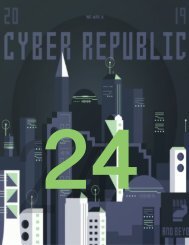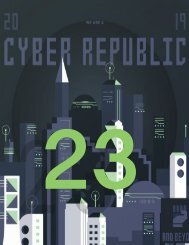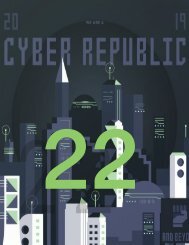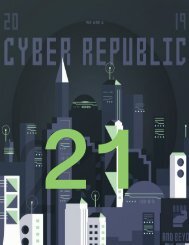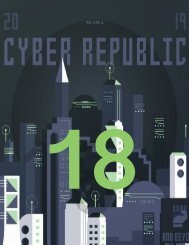Cyber Republic Weekly Update 15
Hello, fellow Cyber Republicans. On the last day of February, the Elastos Foundation published the 2018 Financial Report covering July 2018 to December 2018. https://news.elastos.org/wp-content/uploads/2019/02/Elastos-Financial-Report-English.pdf We will be delving into some details from the report and we’ll share some clarifications Elastos’ leader, Rong Chen, answered for the community. There's also some hot discourse in the community regarding Supernode pools along with a deep dive into DPoS written by yours truly. There is a stunningly active community in the Philippines that, through the voice of Krisha, we’ll be showing their significant activities. And lastly, the Cyber Republic is piling up suggestions on the Cyber Republic website. Vote for the projects you feel are most important. This is our ecosystem and we control our own destiny.
Hello, fellow Cyber Republicans. On the last day of February, the Elastos Foundation published the 2018 Financial Report covering July 2018 to December 2018.
https://news.elastos.org/wp-content/uploads/2019/02/Elastos-Financial-Report-English.pdf
We will be delving into some details from the report and we’ll share some clarifications Elastos’ leader, Rong Chen, answered for the community. There's also some hot discourse in the community regarding Supernode pools along with a deep dive into DPoS written by yours truly. There is a stunningly active community in the Philippines that, through the voice of Krisha, we’ll be showing their significant activities. And lastly, the Cyber Republic is piling up suggestions on the Cyber Republic website. Vote for the projects you feel are most important. This is our ecosystem and we control our own destiny.
Create successful ePaper yourself
Turn your PDF publications into a flip-book with our unique Google optimized e-Paper software.
<strong>15</strong><br />
//1
CYBER REPUBLIC <strong>Weekly</strong> <strong>Update</strong>/Issue <strong>15</strong><br />
Jimmy Lipham @jimmyhacksstuff of PeerJet needs to add more servers<br />
to keep up with the demand of a growing number of Elastos Carrier<br />
Nodes.<br />
Hello, fellow <strong>Cyber</strong> <strong>Republic</strong>ans. On the<br />
last day of February, the Elastos Foundation<br />
published the 2018 Financial Report<br />
covering July 2018 to December 2018.<br />
https://news.elastos.org/wp-<br />
content/uploads/2019/02/Elastos-Financial-<br />
Report-English.pdf<br />
We will be delving into some details from<br />
the report and we’ll share some<br />
clarifications Elastos’ leader, Rong Chen,<br />
answered for the community.There's also<br />
some hot discourse in the community<br />
regarding Supernode pools along with a<br />
deep dive into DPoS written by yours truly.<br />
There is a stunningly active community in<br />
the Philippines that, through the voice of<br />
Krisha, we’ll be showing their significant<br />
activities. And lastly, the <strong>Cyber</strong> <strong>Republic</strong> is<br />
piling up suggestions on the <strong>Cyber</strong><br />
<strong>Republic</strong> website. Vote for the projects you<br />
feel are most important.This is our<br />
ecosystem and we control our own destiny.<br />
Moving into the financial report, it includes<br />
expenditure information in the following<br />
areas: Research and Development, Public<br />
Relations and Marketing, Operations and<br />
Management, Fixed Assets and Ecosystem<br />
Collaboration.The audit was done by Beijing<br />
Shuangdou Accounting Firm.<br />
Elastos Foundation explains:“Beijing<br />
Shuangdou Accounting Firm was engaged by<br />
the Elastos Foundation to audit the expenses<br />
in fiat and digital currency and assets made<br />
between July 2018 and December 2018.The<br />
information included in this Report follows<br />
pertinent regulations in Auditing Standards<br />
for CPAs of China.”<br />
As community members dove into the<br />
Financial Report, some questions were raised<br />
and Rong Chen personally answered several<br />
of these questions in the Telegram chatroom.<br />
//2
There's a post on the <strong>Cyber</strong> <strong>Republic</strong><br />
Forum that overviews everything Mr.<br />
Chen had to say about the Financial<br />
Report.<br />
https://forum.cyberrepublic.org/t/unoffi<br />
cial-telegram-q-a-with-rong-chen/694<br />
The Elastos Foundation doesn't have the<br />
responsibility or legal ability to disclose<br />
all information. When this was pointed<br />
out by a community member, Rong<br />
explained,“Thanks for pointing out that<br />
EF is not CR. We are not going to expose<br />
full financial details, nor BTC addresses,<br />
partially due to legal matters. However, I<br />
do invite [the] Elastos community to<br />
select one or two people with CPA<br />
license to come to come to Beijing at<br />
[the] foundation’s cost, sign an NDA, sit<br />
down with the auditing firm and Elastos<br />
accountants to find out whether Elastos<br />
foundation is true to its words.”<br />
A big question from the community was<br />
getting into the specifics of what<br />
“Ecosystem Collaboration” really<br />
means. Rong was able to explain in full<br />
detail:“DMA, HIVE, SPV wallet, ETH<br />
Sidechains,Trinity Browser, etc. are<br />
partially or completely outsourced. We<br />
are likely to sign contract or to pay for<br />
bonuses at the end or beginning of a<br />
financial circle. Please keep in mind that<br />
Elastos Foundation is not a single<br />
company. People should read [the] EOY<br />
report and check against milestones.<br />
Last night I was talking about 6 months<br />
average BTC expenditures. We will post<br />
a “teams” page in a day or two, to explain<br />
which companies, teams and how many<br />
people were paid for the last 6 months.<br />
Comparing two documents side by side,<br />
you may have a better understanding<br />
what’s going on. Elastos is an open<br />
source Smartweb platform. We tried to<br />
implement it as efficient as possible.” This<br />
settles the argument that the EF is<br />
omitting any specific information.There<br />
are legitimate legal ramifications to<br />
disclosing certain aspects of the<br />
Foundation that they must abide by.<br />
Rong Chen is willing to take suggestions<br />
for other Financial Audits in the future:“If<br />
you find a reputable accounting firm, let<br />
me know. Before you do that please call it<br />
up and make sure it really does crypto<br />
accounting, not some crypto projects<br />
saying they do. Next time we may take the<br />
accounting firm you select seriously. We<br />
will not consider any accounting firm that<br />
charges a quarter million dollars a pop, and<br />
that don’t do cryptos.”<br />
Lastly, he reminds the community that<br />
there are 100 engineers at work. “Here’s<br />
some simple math: 1400 BTC in six months,<br />
in terms of average BTC price of each<br />
month, comes to 4.5 to 5 million USD.<br />
Reading through weekly reports and the<br />
EOY report, Elastos Smartweb takes at<br />
least 100 engineers including outsourcing<br />
plus supporting staff to build, whether it’s<br />
really very efficient team or not, you may<br />
ask Jimmy or anyone with IT management<br />
that you trust. 5,000,000 divided by 100<br />
employees, divided by 6 months, comes to<br />
8333 dollars per month salary, plus office<br />
rent, travels, BD, PR, legal, social security<br />
benefits, everything. Is it too high? I hope<br />
people could see the simple logic behind<br />
before they FUD. ELA expenditure is for<br />
bonuses, incentives for partners, etc. How<br />
many crypto projects are as clean and as<br />
transparent?”<br />
Rong clearly wants what's best for Elastos<br />
and the <strong>Cyber</strong> <strong>Republic</strong>. We thank the<br />
Elastos Foundation and Rong Chen for<br />
giving us a deeper dive into the<br />
expenditures and answering so many<br />
//3
CYBER REPUBLIC <strong>Weekly</strong> <strong>Update</strong>/Issue <strong>15</strong><br />
follow up questions the night the Financial<br />
Report was released.This shows the<br />
dedication and the care Elastos Foundation<br />
has for its community members.<br />
Moving on to another topic, Supernode<br />
elections are almost underway. Wallets are<br />
being tested for Supernode Elections and<br />
voting and is slated to start next week.The<br />
requirement is 5,000 ELA along with<br />
advanced hardware that's suitable to run a<br />
node.<br />
https://news.elastos.org/elastos-dpossupernode-election-process/<br />
Many members have come together on the<br />
<strong>Cyber</strong> <strong>Republic</strong> Forum and have created<br />
discord groups and wechat groups in order<br />
to join together and run multiple<br />
Supernodes. People are getting excited<br />
about being part of a Supernode.Thanks to<br />
Michael S. for creating a post and getting<br />
people together to join different<br />
Supernode Pools.<br />
https://forum.cyberrepublic.org/t/supernod<br />
e-pool-recruitment-and-q-a/648/8<br />
These Supernodes will be elected by the<br />
<strong>Cyber</strong> <strong>Republic</strong> community, and we hope to<br />
compile a list of options for the community<br />
to vote on. We wish everyone luck with their<br />
pools!<br />
As Rong Chen says,“Elastos is building a<br />
BRIGHT WEB...”, we at the <strong>Cyber</strong> <strong>Republic</strong><br />
certainly see the light at the end of the<br />
tunnel.<br />
-By Jeremy G.<br />
//4
Table of Contents<br />
2 Intro<br />
6 New CR Page: Docs<br />
7 Analytics<br />
8 Supernode Elections<br />
11 Summary<br />
12 Shout Out<br />
13 CR Terminology<br />
14 International Activities: DpoS<br />
Alliance<br />
16 Interview: Krisha<br />
21 CR Forum<br />
25 Glossary<br />
27 Credits<br />
//5
CYBER REPUBLIC <strong>Weekly</strong> <strong>Update</strong>/Issue <strong>15</strong><br />
New CR Page: Docs<br />
By Kenneth K.<br />
The <strong>Cyber</strong> <strong>Republic</strong> has released a first draft of the new CR documents page. We’d like to<br />
emphasize that the CR is a completely public and open project. Every aspect of the CR<br />
must therefore be transparent and submitted to the community for comment, discourse,<br />
and debate. In that ideal, these alpha documents are being released and it is our hope that<br />
the community takes the time to look over these materials that act as the laws and<br />
definitions that we all have agreed to abide by.<br />
https://www.cyberrepublic.org/docs/#/<br />
Here is a summary of the materials currently included in this document:<br />
//6<br />
Intro and <strong>Cyber</strong> <strong>Republic</strong> Workflow:<br />
As the CR is only as successful as the community’s involvement in it, this section breaks<br />
down how any individual with any skillset can get involved in the <strong>Cyber</strong> <strong>Republic</strong> in a clear<br />
and easy-to-understand way. This establishes the fair and public protocols that will move a<br />
project from discussion to suggestion to proposal to funding to execution.<br />
User’s Guide:<br />
This is a growing guide that describes not only what suggestions and proposals are, but<br />
also what the <strong>Cyber</strong> <strong>Republic</strong> Secretariat and Council are.<br />
<strong>Cyber</strong> <strong>Republic</strong> Constitution:<br />
The Constitution of the <strong>Cyber</strong> <strong>Republic</strong> is an exciting document that overviews what the<br />
<strong>Cyber</strong> <strong>Republic</strong> as a whole has agreed to, and what protocols have been put in place to<br />
protect the community and its vision. From the values and mission, to voting and<br />
amendments, to conflicts of interest and checks and balances, the CR Constitution is the<br />
bedrock of our new republic.<br />
Media Style Guide:<br />
Branding assets are the unified front of the <strong>Cyber</strong> <strong>Republic</strong>. It is important that the world<br />
can recognize who we are at a glance, and these are the tools to make ourselves seen.<br />
FAQ:<br />
There are always questions, and this document will grow and answer the most common<br />
questions such as funding, definitions, and DPoS consensus mechanisms.
CR Website Analytics: Feb 23 - Mar 1<br />
//7
CYBER REPUBLIC <strong>Weekly</strong> <strong>Update</strong>/Issue <strong>15</strong><br />
Supernode Elections:<br />
There’s a Lot at “Stake”<br />
By Jeremy G.<br />
We are embarking into a new era of Elastos<br />
and the <strong>Cyber</strong> <strong>Republic</strong>. Delegated Proof<br />
of Stake (DPoS) Supernode Voting and<br />
Elections are coming soon to a Wallet near<br />
you.There's been a lot of chatter in the<br />
Telegram chat rooms, subreddit and CR<br />
Forum about Pooling for Supernodes and<br />
what the process is.As wallets are being<br />
tested for elections this week, the voting<br />
looks to start sometime this month.<br />
The first round of elections will conclude<br />
in April, in which the Community Nodes<br />
will begin participating in DPoS<br />
Consensus.This article is meant to give<br />
the community a clear, in-depth look on<br />
important aspects of how DPoS works and<br />
also to suggest some ideas in which node<br />
groups can use in order to properly divvy<br />
out profits to each other and voters.Also,<br />
in order to protect the sanctity of the<br />
DPoS Consensus process, any malicious<br />
activity will result in penalties and<br />
potential dismissal of Supernode status.<br />
First let's break down the DPoS structure<br />
Elastos has devised.There will be 108 total<br />
nodes. 96 of the nodes will be<br />
democratically elected by the community,<br />
and 12 of the nodes will be voted in by the<br />
CR Consensus. Each of the 96 non-CR<br />
Supernodes will need to meet the<br />
requirement of having 5000 ELA locked-up,<br />
along with various hardware requirements<br />
needed to run a node.<br />
Another terms for these non-CR<br />
Supernodes are “Participant Nodes”. 36 of<br />
these nodes will be “active”, with the 12 CR<br />
Nodes always running. The other 72 nodes<br />
will be “stand-by nodes”.The stand-by nodes<br />
with the most votes will take the place of<br />
any inactive Supernodes.<br />
As CR Community Manager Nicola<br />
Zimmmerman (AKA Ghandi) eloquently<br />
explains:“There are 96 nodes which are<br />
voted in by the community and are getting<br />
rewards.The 36 Supernodes are called<br />
active nodes, the 72 stand by nodes become<br />
active nodes when one of the active nodes<br />
goes offline or when they get more votes in<br />
a voting round (every 72 minutes) than the<br />
active node with the least votes.”<br />
In other words, 24 of the 36 Supernodes are<br />
in flux and voted on every 72 minutes.The<br />
nodes with the most votes in the Top 24 will<br />
be Active. Ultimately it's those top 24<br />
Supernodes that will get the most rewards<br />
because they are the most active and will be<br />
processing the majority of the transactions<br />
on the network.<br />
Speaking of rewards, 25% are distributed to<br />
the 36 Supernodes; every active node gets<br />
the same amount. 75% of the rewards are<br />
distributed to the 96 nodes with the most<br />
votes--rewards are distributed<br />
proportionally to the number of votes.The<br />
12 CR nodes don‘t get any part of the 75% of<br />
course since they don’t have to be voted in.<br />
The community will be making decisions on<br />
which Nodes are active and which will be on<br />
stand-by through voting. Ultimately, it's up<br />
to the <strong>Cyber</strong> <strong>Republic</strong>ans to choose the<br />
best and most reliable Supernodes.The<br />
network depends on the reliability of these<br />
//8
Supernodes, so it is important to vote<br />
accordingly.<br />
To understand what these nodes do, it's<br />
important to know what happens before<br />
the DPoS process. Elastos uses a dual<br />
consensus mechanism: Proof of Work (PoW)<br />
and DPoS. Elastos uses Merge Mining on the<br />
Bitcoin blockchain.The PoW miners<br />
produce the blocks and as stated in the<br />
Elastos DPoS Supernode Election article:<br />
https://news.elastos.org/elastos-dpossupernode-election-process/<br />
“The 36 active nodes will confirm the<br />
blocks previously produced by PoW<br />
miners.”<br />
Between the miners using PoW and the<br />
Supernodes using DPoS, this is how Elastos<br />
reaches full consensus for all transactions<br />
made in the ecosystem.<br />
For those interested in running your own<br />
node on the Elastos network, you’re in for a<br />
treat.There are several different avenues<br />
available. Many in the community are<br />
congregating together to build teams that<br />
will run Supernodes.There have been a<br />
number of proposals on how the payouts<br />
will be properly structured and also ensure<br />
there isn't any illicit activity between team<br />
members and voters.<br />
The first method is the use of the multisignature<br />
function in the Elastos wallet.<br />
Teams can set up a multisig wallet which<br />
requires a certain number of pool<br />
participants to sign the transaction.There’s<br />
a maximum of six and minimum of two<br />
owners to each wallet, and up to four<br />
required signatures to sign off on<br />
transactions.This ensures that multiple bad<br />
actors would be needed to betray the trust<br />
of a supernode team.<br />
This may be the easiest method, but it may<br />
not be the most ideal. Gandhi explains a bit<br />
more why a multi-sig option may not be the<br />
best course of action:“A multisig wallet is<br />
the easiest solution in my opinion but it<br />
has some deficiencies. For example, if one<br />
of the pool participants wants to leave the<br />
pool, you have to make a new multisig<br />
wallet, transfer the 5k ELA to a new wallet<br />
and register again for the election.” The<br />
constant flux of changing team members<br />
and creating new wallets may cause some<br />
headaches and become somewhat timeconsuming.<br />
Votes could be lost in the<br />
process.This brings us to a potential<br />
solution to this problem: creating smart<br />
contracts to streamline the process<br />
better.<br />
Smart contracts are the method in terms<br />
of divvying up ownership of a node and<br />
distributing rewards to its voters. Gandhi<br />
continues:“With a smart contract, one<br />
could find a solution to sell their stake of<br />
the node without the node having to go<br />
offline.The smart contract (or a second<br />
one) could also be used to share the block<br />
rewards with the voters. For example, you<br />
create a smart contract and deposit 5k ELA<br />
in it as a pool. The node owners set how<br />
much of their block rewards they want to<br />
share with their voters (ie. 80% for voters,<br />
<strong>15</strong>% for pool participants, 5% for running<br />
and maintaining the hardware).The smart<br />
contract detects automatically who is<br />
voting for your node and distributes the<br />
voting rewards. It doesn‘t make sense to do<br />
this in every block because this would be<br />
way too expensive, but let‘s say every 2<br />
weeks and as a voter you only get<br />
rewarded when you voted for the node for<br />
the whole 2 weeks period. The smart<br />
contract automatically distributes the<br />
rewards to the pool participants”.The<br />
Supernode pools can essentially automate<br />
the process in distributing rewards<br />
amongst themselves along with their<br />
community voters through smart<br />
contract.This would give many interested<br />
parties peace of mind that everything is<br />
being controlled by code.<br />
//9
CYBER REPUBLIC <strong>Weekly</strong> <strong>Update</strong>/Issue <strong>15</strong><br />
So how exactly does one go about creating a<br />
smart contract in order to compensate<br />
members of a Supernode pool or CR voters?<br />
Well, the answer isn't simple yet.There are a<br />
few details to iron out in the process of<br />
enabling a fully-functional smart contract that<br />
distributes ELA funds to multiple parties.<br />
Software Development Relations Manager,<br />
Kiran Pachhai (KP) explains the creation of a<br />
smart contract in this specific Supernode<br />
context:“You can’t write a smart contract for<br />
ELA payments. Since that is done via main<br />
chain and main chain doesn’t run smart<br />
contracts. One option is maybe through smart<br />
contracts on Eth or Neo sidechain that keeps<br />
track of all the votes, rewards, etc. and based<br />
on certain triggers like a monthly date, it<br />
triggers another action which will auto<br />
distribute the ELA into a wallet.The handling<br />
of ELA payments itself could be done via<br />
scripting, same as how you would do BTC<br />
payments via scripting.The voting type<br />
transactions are different on main chain so<br />
you could write something based on that.A<br />
Supernode is just a machine that runs<br />
arbitrator code. You can’t write a smart<br />
contract for a supernode. You can only write<br />
logic onto a smart contract and put it on the<br />
Blockchain.After a certain event or trigger, it<br />
can execute the script that then autodistributes<br />
ELA to people. Then again, you<br />
could possibly do the entire thing as scripting<br />
alone.”<br />
As you can tell, though it would take an<br />
experienced developer in order to automate<br />
the process through smart contract and<br />
scripting, it looks to be the safest and most<br />
efficient path in order to assign payments to<br />
Pool members or voters.<br />
But what about the prevention of bad actors<br />
in the ecosystem? Elastos Foundation has the<br />
proper rules and infrastructure in place in<br />
order to weed out the bad apples.As stated<br />
earlier in the article, the Participant Nodes<br />
need to lock up 5000 ELA.This stashed ELA<br />
acts as collateral in case any sketchy activity<br />
occurs or rules are broken.This is explained<br />
in the Elastos DPoS Supernode article when<br />
Supernodes don't act accordingly:“...if the<br />
node is found to have violated the rules, the<br />
appropriate amount will be deducted from<br />
the ELA on deposit according to the<br />
situation and the remaining ELA will be<br />
returned to the wallet address linked to the<br />
public key that was provided at the time of<br />
registration.” There isn't a set amount<br />
determined in terms of how much ELA<br />
would be deducted to such bad actors, but<br />
they will certainly be penalized. It's good to<br />
know that there are certain rules and<br />
regulations to be followed for all Participant<br />
nodes without exception.<br />
There are plenty of other DPoS Consensus<br />
blockchain projects out there, some like<br />
ARK which work well and are user-friendly<br />
with payouts to voters being as simple as<br />
voting for someone with the best reputation<br />
and rewards, and receiving those rewards in<br />
your wallet on a weekly basis. And others<br />
like Lisk which have a cartel running it which<br />
does not pay out any rewards to voters<br />
unless you vote for the entire cartel, and the<br />
rewards for doing so are generally<br />
inconsequential.<br />
As you can tell, there are a lot of nitty-gritty<br />
details that come with the DPoS<br />
Supernodes. Most importantly, however,<br />
these Supernodes will be able to secure and<br />
confirm transactions to keep the reliability<br />
of the network fully intact. It's up to the<br />
community to continue to vote for the<br />
Supernodes that represent the best<br />
interests of Elastos and the <strong>Cyber</strong> <strong>Republic</strong><br />
Ecosystem.<br />
<strong>Cyber</strong> <strong>Republic</strong>ans, there's a lot at stake with<br />
these Supernode Elections and Voting, no<br />
pun intended.<br />
//10
Summary<br />
Here is the latest Elastos <strong>Weekly</strong> <strong>Update</strong>:<br />
https://news.elastos.org/elastos-weekly-updates-01-march-2019/<br />
We have a new <strong>Cyber</strong> <strong>Republic</strong> Documentation site with relevant introductory information about the<br />
<strong>Cyber</strong> <strong>Republic</strong>, including the constitution, voting and proposals, and leadership. Check it out here:<br />
https://www.cyberrepublic.org/docs/#/overview/intro<br />
Project <strong>Update</strong>s<br />
<strong>Cyber</strong> <strong>Republic</strong> Website<br />
Main Project Repo: https://github.com/cyber-republic/<strong>Cyber</strong><strong>Republic</strong><br />
Git Activity and <strong>Update</strong>s<br />
Please refer to the timeline described on this article for more info:<br />
https://blog.cyberrepublic.org/2018/12/27/important-cyber-republic-announcement<br />
If you are a developer interested in working with the CR or Elastos, here’s a form you can fill out:<br />
https://goo.gl/forms/pvzDYMsVEs10s6U72<br />
//11
CYBER REPUBLIC <strong>Weekly</strong> <strong>Update</strong>/Issue <strong>15</strong><br />
Community<br />
Shout Out!<br />
https://todaysgazette.com/world-bank-is-finding-elastos-ela-use-cases-outstanding/<br />
Olayode Yusuff dropped an article on Today’s Gazette that discusses a meeting<br />
between Elastos Co-Founder Sunny Feng Han and CR Interim Council Member<br />
Kevin Zhang with The World Bank.<br />
//12
CR Terminology<br />
By Kenneth K.<br />
As there are many terms to such a large project like Elastos and the <strong>Cyber</strong> <strong>Republic</strong>, we’ve<br />
decided to build a growing glossary of terms that can help the less technical understand better<br />
what the tech means and the impact it could have. This week we’re focusing on the term:<br />
Sidechain.<br />
Term: Sidechain<br />
A sidechain is a discrete sub-blockchain linked to the main chain which enriches the capabilities<br />
of the main chain. Assets are exchanged between the main chain and sidechain at a<br />
predetermined rate, but because calculations can be solved on separate chains simultaneously,<br />
capacity is greatly increased. For instance, in other blockchains utilizing sidechains a user on a<br />
parent chain sends their tokens to an output address where the tokens are locked. A<br />
corresponding amount of tokens is released on the sidechain and the user is then able to utilize<br />
the tokens on the sidechain in several transactions before returning the sidechain tokens back<br />
to the main chain via the same locking mechanism. Elastos’ mechanism utilizes the same private<br />
key across mainchain and sidechains, and transfers between them are facilitated through<br />
arbitrators--the 36 Supernodes which run one node of every single chain: main chain, DID<br />
sidechain,Token sidechain, and so on so forth. Sidechains are responsible for their own security.<br />
If there is a problem in the sidechain or mainchain, they do not necessarily impact each other.<br />
Reference:<br />
https://cryptodigestnews.com/what-are-sidechains-and-childchains-9c4a944e68f<br />
Layman’s definition:<br />
Think of a sidechain as a local road parallel to a highway. Perhaps this local road has several more<br />
intersections and stop signs and traffic moving in different directions. If these intersections and<br />
stop signs were put on the highway, things would easily slow down to full-blown traffic jam--<br />
maybe even the majority of the time. By adding these local roads parallel to the highway, it allows<br />
specific traffic to exit and get to particular places at particular times, which keeps the highway<br />
itself uncongested and freely moving.<br />
Elastos uses a number of sidechains, each specifically designed for one type of traffic. DID<br />
sidechain just for issuing decentralized IDs and storing information for each DID. Token<br />
sidechain which has the sole purpose of issuing fungible and non-fungible tokens. Ethereum<br />
sidechain to mimic anything that Ethereum can do through smart contract or function. NEO<br />
sidechain to mimic NEO’s smart contracts and functions.<br />
//13
CYBER REPUBLIC <strong>Weekly</strong> <strong>Update</strong>/Issue <strong>15</strong><br />
International Community<br />
Activities<br />
By Joel<br />
In last weekly update, we discussed the DPoS alliance initiated by the Chinese community.As<br />
the alliance states, the purpose of running the nodes is not for profit but for the following<br />
reasons:<br />
Provide a way for token holders to benefit from the DPoS node elections;<br />
Encourage members to vote; and<br />
Prevent the collusion of “whales”.<br />
Voter Benefits<br />
With the current election rules, no rewards are given for voting in the DPoS elections.To<br />
encourage the community to participate, the alliance will reward its voters. ELA deposited to<br />
become a node candidate will weigh twice as much as ELA used to vote.This serves to<br />
compensate those taking the extra risk of depositing ELA, as well as the initial set-up cost of<br />
hardware. When deciding the weight factor, there were some considerations for the node<br />
candidates. The rewards cannot be:<br />
too low: if the reward is too low, node candidates will not be attracted and it may<br />
cause collusion between the nodes during elections; or,<br />
too high: it is unfair to voters and it will not attract enough members to join the<br />
alliance<br />
This alliance encourage members to vote by maximizing the yield of every ELA they use to vote<br />
with. Referencing the formula given in the last weekly update, the percentage of the profit<br />
given to node committee decreases (and rewards given to the voters increases) with an<br />
increase in voting rate. Here are some figures:<br />
//14
Though rewards to voters are increasing, the absolute amount for the nodes will still<br />
increase as the alliance receive more profit as a whole. In short, this formula increases<br />
the profit of both voters and the nodes with more gains to the voters the more voters<br />
there are.<br />
Preventing the collusion of “whales”<br />
The circulating ELA is about 14.6 million. If 1 ELA is allowed to cast 1 vote, the number of<br />
votes required to secure a node is about 14.6M/96=<strong>15</strong>2K. When 1 ELA is allowed to cast<br />
36 votes, the number of votes to secure a node is about 36*14.6M/96=5.48M (which<br />
secures all 36 nodes if members of an alliance are forced to vote for candidates of the<br />
same alliance). If one believes that forming alliances is the best way to secure personal<br />
benefits, it’s natural that eventually there will be several major alliances competing for<br />
votes.The alliances receiving the most votes will become the 24 Supernodes and the 12<br />
nodes ranking from 37 to 48.<br />
Thus, the bar for securing a node is significantly raised. It’s easier for the rich to<br />
coordinate an alliance. From the angel wallets, the first 24 angles hold about 4.25M ELA.<br />
Using the blockchain explorer as reference, the first 24 wallet holders hold around<br />
3.57M ELA. It should be said clearly that there is no inference that these wallet holders<br />
will collaborate. What is highlighted is the actual holdings compared to the threshold.<br />
It should be noted that this alliance is recruiting members from the international<br />
community, and the goal is to encourage community participation through a proper<br />
incentive structure and to prevent the potential dominance of the rich via collusion.<br />
Community members are invited to discuss the possible scenarios and ways that<br />
benefit the community the most. Here is a forum post discussing it:<br />
https://forum.cyberrepublic.org/t/dpos-alliance/669<br />
//<strong>15</strong>
CYBER REPUBLIC <strong>Weekly</strong> <strong>Update</strong>/Issue <strong>15</strong><br />
Interview: Krisha<br />
By Jeremy G.<br />
Tell us a little about yourself... where did you go to<br />
school? What was your major?<br />
At the age of 20, I graduated with a Bachelor’s of<br />
Science in Computer Science at STI College Global<br />
City. I started as an intern at Cognizant Technology<br />
Solutions, a BPO company. I was assigned to a<br />
Network and Services Systems office where I<br />
learned how IT operates in the real world. I also<br />
took a one-year vocational course for Computer<br />
Systems Servicing NC II at TESDA.<br />
I often accepted remote jobs online. I was a<br />
researcher for a US-based cryptocurrency investor.<br />
He introduced me to blockchain and<br />
cryptocurrencies. He was the reason why I have my<br />
position right now in Elastos. What I did then was<br />
look over the coins on coinmarketcap.com for<br />
some tokens with good forward prospects. Among<br />
these was Elastos.<br />
I recommended Elastos to my employer and he<br />
followed my recommendation. I met the lead<br />
evangelist of Elastos, Clarence, at a meetup in San<br />
Francisco. Elastos had been looking for an<br />
organizer to manage a meetup in Manila and my<br />
previous employer suggested me to Clarence.<br />
When the event was first posted on meetup.com,<br />
Mr.Alex Timbol was among the first to RSVP, so I<br />
messaged him and asked if he could help me out.<br />
I am a Community Organizer and representative of<br />
Elastos here in the Philippines where my persona is<br />
the “Elastos Princess”. This persona helps to<br />
market blockchain to colleges and other young<br />
developers. I'm helped by my Mom's food and<br />
catering business, and by a veteran sales and<br />
marketing professional who advises me and helps<br />
out in Elastos' Philippines activities.<br />
Alex has years of experience in corporate<br />
communications for a food and<br />
beverage company, and decades of<br />
experience in Institutional<br />
Stockbroking around Southeast<br />
Asia. He has worked in social<br />
entrepreneurship, community<br />
organizing, events management,<br />
PR crisis management, and<br />
disaster response.<br />
He is based in Metro Manila, and I<br />
am in Central Luzon, around<br />
120km apart, so he can quickly<br />
attend to requirements in the<br />
National Capital while I am near<br />
enough to make a day trip if<br />
necessary. But, Central Luzon,<br />
where I am, is among the regional<br />
//16
software and blockchain development<br />
supercenters due to the Clark and Subic<br />
Freeports.<br />
I recently started working in Network<br />
Security Support at a Company in Central<br />
Luzon.<br />
What are your hobbies? Any special activities<br />
you like to do with friends and family?<br />
Whenever I have free time, I watch American<br />
TV or Asian anime series. My family and I go to<br />
the beach and attend concerts together.<br />
We're a very close family. My mom has a food<br />
service business, Raemily's, and sometimes I<br />
help out, gaining valuable practical<br />
experience, just as Jeff Bezos said he worked<br />
at McDonald's in his teens.<br />
Raemily's handled catering and logistics<br />
during the October 13 event, and I can always<br />
rely on my Mom and her crew for support.<br />
You set up an Elastos meetup in the<br />
Philippines, how did it go?<br />
On October 9, 2018, Clarence went to Manila<br />
for two things: First, Elastos purchased a<br />
booth at Blockchain Fair Asia on October 10-<br />
11, 2018. I worked with Clarence to set up the<br />
booth and meet the other local and foreign<br />
blockchain personalities, including the<br />
leadership at NEM Philippines, with whom we<br />
now have a cooperative arrangement.<br />
On October 13, 2018, I organized the first ever<br />
meetup of Elastos in the Philippines. Clarence<br />
Liu was the speaker and it was his first time to<br />
visit the Philippines.The meetup lasted for 4<br />
hours.The number of attendees exceeded<br />
100. It set benchmarks in the local Blockchain<br />
industry in terms of attendance, relevance of<br />
audience, and number of newbies to<br />
blockchain.<br />
We had over 40 tech students from two<br />
campuses Cavite State University, the largest<br />
University system in Southern Luzon. Other<br />
blockchains and crypto events had as little as<br />
10 attendees, and there were few with more<br />
than fifty attendees--usually the same regular<br />
enthusiasts. With Elastos, we wanted to<br />
ensure that we had more and that we would<br />
break records, so we reached out to IT and<br />
student groups via their social media pages,<br />
and I personally I invited them with<br />
persistent PMs and emails.As a result, we had<br />
over a hundred attendees from different<br />
communities. Even Star Trek Philippines<br />
teleported over to learn about the Internet<br />
of the Future. In the real world, STP members<br />
are professionals in tech and content<br />
creation.<br />
You can watch the event video on youtube<br />
here:<br />
https://youtu.be/QiuKCmHHJtM<br />
Are there going to be any future meetups?<br />
We have been continually participating in 3-5<br />
tech events per month that may be roughly<br />
categorized into into three categories:<br />
Networking events, brand presence, and<br />
educational events. It is a continuous<br />
campaign.<br />
Despite limited resources, Elastos is<br />
probably amongst the top five most well<br />
known blockchain developments in the<br />
Philippines, along with the well-funded NEM,<br />
corporate-backed EOS, app wallet enabler<br />
Stellar, and universally known Ethereum.<br />
For many of the communities we are<br />
reaching out to, we are the first to present<br />
blockchain in general, and Elastos in<br />
particular.<br />
Notable networking events we've attended<br />
have been “Women in Blockchain”, with<br />
whom I am working with to establish a<br />
Central Luzon chapter with other female<br />
blockchain developers based in Pampanga,<br />
my home province, and nearby Zambales,<br />
Bataan, and Nueva Ecija; PADCDI (Philippine<br />
Association of Distributed Computing<br />
Developers, Inc.) annual meeting, which<br />
includes key personalities from the<br />
blockchain focussed CEZA (Cagayan<br />
//17
CYBER REPUBLIC <strong>Weekly</strong> <strong>Update</strong>/Issue <strong>15</strong><br />
Economic Zone Authority in Northeastern<br />
Luzon), and the prominent Loyalcoin, headed<br />
by local celebrity Paolo Bediones, which runs<br />
loyalty programs built upon the NEM<br />
blockchain; and Fintech Philippines, which is<br />
heavy on professionals in the formal financial<br />
sector, and auditing and consulting firms.<br />
Alex has also participated in government and<br />
industry events representing Elastos to build<br />
links with relevant state offices. Key events<br />
he's attended are the DICTs Internet<br />
Governance symposium which connected us<br />
to leading regional tech players and<br />
infrastructure providers, and the larger<br />
DICTs Incubators annual meetup attended<br />
by tech incubator operators around the<br />
country.This has enabled us to obtain access<br />
to key officials and identify state programs<br />
that sync with Elastos' objectives.<br />
One example is DICTs Rural Impact Sourcing<br />
program which trains countryside folk to<br />
access online paying jobs in software<br />
development, web development, content<br />
creation and design. If we can form a<br />
partnership with them, we could have Elastos<br />
development and content creation among<br />
their recommendations list.<br />
We have brand presence activities by proxy<br />
with college and university tech groups, and<br />
moving forward, with several key dev groups.<br />
We provide them event support in terms of<br />
snacks and food items, and they place a large<br />
vertical banner at their venue while<br />
encouraging members to sign up for <strong>Cyber</strong><br />
<strong>Republic</strong>. We've done this at the University of<br />
the Philippines, Polytechnic University in<br />
Quezon City, Unibersidad de Manila, and<br />
recently De La Salle University's Computer<br />
Engineers. It's cost efficient, and doesn't<br />
require our presence.<br />
Last Christmas, we participated in two<br />
blockchain event Christmas parties, where<br />
we also brought along a group of students<br />
from universities we've been in touch with.<br />
//18<br />
Levelling up, we conduct, on a recurring<br />
basis, booth presence during school tech<br />
events, where we have a booth display and<br />
sign ups for the <strong>Cyber</strong> <strong>Republic</strong>. In these<br />
events, I lead the booth team, sometimes<br />
with Alex, sometimes with a team of<br />
students from the host school or an<br />
organization from another school. We are<br />
able to collect dozens of sign ups and<br />
strengthen links with the school<br />
organizations, as well as other Elastos<br />
enthusiasts. We've done this at De La Salle<br />
University and Unibersidad de Manila as<br />
sponsors of events organized by Coding<br />
Girls, organizers of school events; and at<br />
FEU-Tech and Angeles University upon the<br />
invitation of student groups themselves. We<br />
have around a dozen more invitations for<br />
the months ahead.<br />
So, that's our secret. Rather than organize<br />
our own events, we support and participate<br />
in student organization led events if it<br />
provides the right audience for Elastos. It<br />
reduces costs per signup, and minimizes<br />
logistical requirements, and we provide<br />
value by linking up student groups from<br />
other schools and signing them up to <strong>Cyber</strong><br />
<strong>Republic</strong>.<br />
The highest level of involvement we do is a<br />
speaking event.Alex spoke at two such<br />
events sponsored by Elastos. At the College<br />
of St.Benilde School of Arts and Design, he<br />
spoke on the basics of blockchain and how<br />
Elastos provides a secure publishing<br />
platform to monetize creative works.At La<br />
Verdad Community College's ICT Week, he<br />
spoke on SMEs and Startups, in deference to<br />
the Blockchain talk by our friends at NEM. In<br />
both cases, Elastos branding was clearly<br />
presented and the technology welldiscussed<br />
during the speeches.<br />
Our involvement with LVCC has even<br />
greater potential going forward. Located in<br />
Southern Pampanga, they have the largest<br />
school campus in that area, with a student<br />
body known for their skills in mass
communications. We hope that we can work<br />
with them as they evolve into a technology<br />
hub in their area, a complementary partner<br />
to the already established MetroClark ICT<br />
Council in Northern Pampanga, with whom<br />
we have also connected.<br />
How is the interaction with the community in<br />
the Telegram and Facebook groups that you<br />
run?<br />
Our interaction is really good! We always<br />
make sure to share latest news about Elastos<br />
especially on Telegram. We encouraged<br />
students we met to join us to our facebook<br />
group. We post some videos and resources to<br />
increase their knowledge of Elastos.<br />
The Telegram group incorporates the global<br />
Filipino diaspora, some developers, and<br />
others are crypto investors of Elastos<br />
enthusiasts.The Elastos Philippines<br />
Facebook group is more local in character;<br />
membership includes students and<br />
developers seeking updates on Elastos. Much<br />
work still needs to be done to encourage<br />
interaction among these members.<br />
If you were to give the Elastos Foundation<br />
any constructive criticism , what would it be?<br />
Elastos Foundation needs to grow beyond<br />
crypto enthusiasts and developers and craft<br />
marketing programs for the different<br />
stakeholders in its ecosystem, from<br />
consumers to content creators. We've<br />
identified that developers, independent<br />
content creators, content publishers, secure<br />
financial transactions, and consumers are<br />
key stakeholders of the ecosystem.Another<br />
would be VCs to fund promising software<br />
and hardware projects being built using<br />
Elastos technology.<br />
I could say that we've already gone ahead of<br />
Elastos, presenting the technology as a<br />
secure means for content creators to<br />
monetize their works.Alex delivered a talk at<br />
College of Saint Benilde, to its students in<br />
content creation, and we attended the local<br />
launch of Huion, meeting animators and<br />
anime artists, including the Head of the<br />
Cebu Animators Guild, who is enthusiastic<br />
to encourage independent animators to<br />
publish on elastos.At both events, and at<br />
others, content creators are eager to<br />
publish on a secure platform where they can<br />
monetize their works.<br />
We'd like to see more push in branding as a<br />
consumer technology, much like “Intel<br />
Inside.” Widespread awareness sparks<br />
widespread interest in developing and<br />
publishing on the platform in a circle that<br />
could leapfrog Elastos way ahead of similar<br />
rivals.<br />
Elastos' advantage is that it has a consumer<br />
device on the market, according to the CTO<br />
of another network blockchain Alex spoke<br />
with. Let's build on this. Soon, there could be<br />
tens of millions of TV boxes, and Elastos<br />
enabled Wi-fi (like Fon), Elastos secured<br />
smart homes and home devices, as Rong<br />
Chen mentioned on LinkedIn.<br />
What are your thoughts about the <strong>Cyber</strong><br />
<strong>Republic</strong>?<br />
<strong>Cyber</strong> <strong>Republic</strong> underwent an overhaul<br />
shortly after we introduced Elastos to the<br />
Philippines in October 2018. Such an open<br />
platform may be prone to abuse, with some<br />
gaming the tasks system at the expense of<br />
legitimate projects. I understand it's being<br />
reworked to be more effective, and we are<br />
eagerly awaiting a revamped <strong>Cyber</strong><br />
<strong>Republic</strong>.<br />
That aside, it's a fantastic idea to have a<br />
forum for the global community, with the<br />
caveat that there may be competitors,<br />
fraudsters, spies and other unsavories<br />
lurking within its confines. The site needs<br />
more focus and structure. It should be<br />
easier to find people and form groups, and<br />
there should be private workspaces for<br />
virtual teams.<br />
//19
CYBER REPUBLIC <strong>Weekly</strong> <strong>Update</strong>/Issue <strong>15</strong><br />
Are you hopeful for the future of this<br />
ecosystem? Any comments, concerns or<br />
insight would be greatly appreciated.<br />
The ecosystem already exists. It's huge.A<br />
million TV boxes are in consumers' homes<br />
distributing DRM protected content made<br />
by thousands in the content creation<br />
industries. It can be ten million TV boxes, or<br />
over a billion Elastos enabled devices of<br />
various types in homes worldwide.<br />
We've been asking Clarence to encourage<br />
hardware partners to distribute in the<br />
Philippines.At the moment, according to the<br />
node map, there is only one such device in<br />
the Philippines and it's in my house. With<br />
over 300,000 Mainland Chinese working here,<br />
and around five million Filipinos of Chinese<br />
descent eager for Chinese language<br />
content, local tech importers are keen to<br />
bring in the device.<br />
Have you been in contact with any<br />
developers or businesses in the Philippines<br />
area that are in the beginning stages or<br />
incorporating the Elastos technology?<br />
currencies.<br />
So, we've raised awareness and know that we<br />
need to move onwards to yet another higher<br />
level, delivering lectures on programming on<br />
the Elastos blockchain and conducting<br />
Elastos hackathons. We hope to identify and<br />
recruit a capable developer into our team so<br />
we may push forward with this.<br />
We've been able to build links with dozens of<br />
school tech organizations, and several<br />
national tech societies, opening doors for us<br />
to participate in their events going forward.<br />
Examples of these are ISSA (Information<br />
Systems Security Association) and related<br />
Junior ISSA in colleges, JPCS (Junior<br />
Philippines Computer Society), and various<br />
other specialized tech groups providing us<br />
access to their events schedules from which<br />
we may select. It will be busy year.<br />
Our goal is to introduce Elastos to tech<br />
communities around the country, creating<br />
Elastos enthusiast cells, who may further<br />
organize and participate in events in their<br />
areas.<br />
We introduced Clarence to developers<br />
within their own development houses in the<br />
Philippines during his visit. Most have<br />
reviewed the technology, provided some<br />
feedback, mostly about the yet-to-be<br />
completed tools, but they are eager to work<br />
on the platform.<br />
Earlier, I mentioned that we've been<br />
promoting Elastos technology among young<br />
student devs. We've reached out to<br />
thousands, and with school break coming up<br />
soon, we'll remind them of Elastos and<br />
encourage them to experiment on the<br />
platform.<br />
We're in touch with wallet developers<br />
coins.ph and TagCash, both popular in<br />
Southeast Asia and proposing that they<br />
include ELA among their supported<br />
//20
CR Forum Analytics:<br />
Feb 22 - Mar 1<br />
//21
CYBER REPUBLIC <strong>Weekly</strong> <strong>Update</strong>/Issue <strong>15</strong><br />
CR Forum Highlights<br />
By YY<br />
For those who are too busy to visit our CR forum regularly,<br />
we’ve summarized some of the popular topics for this week:<br />
DPoS “Alliance”<br />
If you read our previous CR weekly, you may have come across the DPoS Node<br />
Rights Alliance being set up to allow more token holders to participate and<br />
benefit from the election.“KenNinja” has raised concerns in regards to the<br />
formation of this alliance, its impact to the general community if manipulation<br />
is possible through this alliance, as well as the pros and cons of the model being<br />
proposed. Feel free to leave your comments in the following link:<br />
https://forum.cyberrepublic.org/t/dpos-alliance/669<br />
Unofficial Telegram Q&A with Rong Chen<br />
As discussed in the intro, following the release of Elastos financial report, Rong<br />
Chen visited the Elastos telegram group to have an unofficial Q&A session with<br />
the community members. Some of the questions raised were:<br />
Lack of detail to the audit and financials<br />
Nature of substantial BTC expenditure for ecosystem collaboration<br />
Concern regarding legal issues for Elastos decentralised network<br />
Misunderstanding of Elastos total expenditure in year 2018<br />
Any other blockchain projects that are competing with Elastos<br />
If you would like to find out more about the discussion and read Rong’s<br />
answers, visit the following topic in the forum:<br />
https://forum.cyberrepublic.org/t/unofficial-telegram-q-a-with-rong-chen/694<br />
//22
Supernode Pool Recruitment and Q&A<br />
Following the upcoming DPoS supernodes election, one of the community members,<br />
Michael Stack (known as “mikestack11”) has started this topic to gather community<br />
members who are interested in joining or creating supernode pools. He also discusses<br />
topics surrounding how the multi-signature wallets will operate for these pools.Though<br />
there are numerous members who have already expressed their interest to join or create<br />
a pool, some of them are concerned about if there is mechanism to penalise bad actors as<br />
well as the flexibility of rules and terms, including the implementation of transparent and<br />
customizable legal smart contracts for each member in the pool. If you are interested in<br />
this discussion, check out the following link:<br />
https://forum.cyberrepublic.org/t/supernode-pool-recruitment-and-q-a/648/6<br />
<strong>Cyber</strong> <strong>Republic</strong> <strong>Weekly</strong> <strong>Update</strong> 25 February 2019<br />
Starting last week, a topic will be created for all future CR weekly reports in the forum so<br />
that any feedback or comments can be presented and discussed in one place.These<br />
weekly updates are a source of reliable information about CR and Elastos. If you are a<br />
regular reader of our CR weekly report, please keep a lookout for the new weekly forum<br />
topic and drop your comments, questions, and concerns there.The following link is for<br />
the last week report:<br />
https://forum.cyberrepublic.org/t/cyber-republic-weekly-update-25-february-2019/666<br />
NEO Dev Con and NEO 3.0, are we “wasting” our time?<br />
“KenNinja” has created another topic about the potential ‘waste’ of time in technical<br />
development undertaken by Elastos to become compatible with NEO virtual machine as<br />
the NEO blockchain may change its infrastructure over time. However, Kiran Pachhai, the<br />
Elastos’ Software Development Relations Manager, provides insight regarding the<br />
sidechain infrastructure of Elastos and how this ensures that however the new NEO<br />
blockchain ends up, the NEO sidechain on Elastos will still function as normal.This is the<br />
difference between NEO public blockchain and NEO virtual machine (which is to be<br />
ported to the Elastos main chain). Have a glance at this topic if you are interested:<br />
https://forum.cyberrepublic.org/t/neo-dev-con-and-neo-3-0-are-we-wasting-our-time/6<strong>15</strong><br />
//23
CYBER REPUBLIC <strong>Weekly</strong> <strong>Update</strong>/Issue <strong>15</strong><br />
Check out these hot topics to see if there is anything that you can contribute to, or simply<br />
express your thoughts to help make the forum a truly vibrant community.<br />
Top New Topics<br />
Supernode Pool Recruitment and Q & A<br />
https://forum.cyberrepublic.org/t/supernode-pool-recruitment-and-q-a/648/24<br />
Unofficial Telegram Q&A with Rong Chen<br />
https://forum.cyberrepublic.org/t/unofficial-telegram-q-a-with-rong-chen/694<br />
DPoS “Alliance”<br />
https://forum.cyberrepublic.org/t/dpos-alliance/669/3<br />
<strong>Cyber</strong> <strong>Republic</strong> <strong>Weekly</strong> <strong>Update</strong> 25 February 2019<br />
https://forum.cyberrepublic.org/t/cyber-republic-weekly-update-25-february-2019/666<br />
Spotlight Series - Elastos Browser (Trinity)<br />
https://forum.cyberrepublic.org/t/spotlight-series-elastos-browser-trinity/622<br />
Most Active Topics (in terms of number of views and replies)<br />
//24<br />
Hyper.im - Peer-to-Peer Instant Messenger<br />
https://forum.cyberrepublic.org/t/hyper-im-peer-to-peer-instant-messenger/289<br />
Marketing & awareness of Elastos & The <strong>Cyber</strong> <strong>Republic</strong><br />
https://forum.cyberrepublic.org/t/marketing-awareness-of-elastos-the-cyber-republic/102/8<br />
Bi-weekly livestream with Rong Chen<br />
https://forum.cyberrepublic.org/t/bi-weekly-livestream-with-rong-chen/107/7<br />
Supernode Pool Recruitment and Q & A<br />
https://forum.cyberrepublic.org/t/supernode-pool-recruitment-and-q-a/648/25<br />
Hyper.im - Beta now available<br />
https://forum.cyberrepublic.org/t/hyper-im-beta-now-available/348/14<br />
dApp idea thread<br />
https://forum.cyberrepublic.org/t/dapp-idea-thread/342/12
Glossary<br />
A growing list of Terms and their definitions<br />
Elastos Hive Cluster:<br />
a decentralized File Storage Service that based on IPFS cluster. For more<br />
information:<br />
https://blog.cyberrepublic.org/2019/02/19/weekly-report-february-18-2019/<br />
Elastos React Native:<br />
a Javascript framework for developing dapps, similar to Trinity’s Ionic<br />
framework, but native to Android and iOS. For more information:<br />
https://blog.cyberrepublic.org/2019/02/05/weekly-report-february-4-2019/<br />
Elastos Sidechain:<br />
a scaling solution that utilizes parallel blockchains to the main chain in order<br />
decrease transaction congestion on the main chain.<br />
//25
CYBER REPUBLIC <strong>Weekly</strong> <strong>Update</strong>/Issue <strong>15</strong><br />
Feel free to leave a comment with your concerns, questions, and suggestions<br />
(or praises), for the <strong>Cyber</strong> <strong>Republic</strong>.<br />
JOIN US ON<br />
Telegram- https://t.me/elastosgroup<br />
Reddit-https://www.reddit.com/r/<strong>Cyber</strong><strong>Republic</strong>/<br />
GitHub-https://github.com/cyber-republic<br />
Youtube-https://www.youtube.com/channel/UCjHthS-zJr0axZF5Iw8En-w<br />
Discord-https://discordapp.com/invite/UG9j6kh<br />
Instagram-https://www.instagram.com/cyberrepublic/<br />
Twitter--https://twitter.com/cyber__republic<br />
LinkedIn-https://www.linkedin.com/company/cyber-republic/<br />
Facebook-https://www.facebook.com/Elastos<strong>Cyber</strong><strong>Republic</strong><br />
//26
Credits:<br />
Writers:<br />
Kenneth K<br />
Jeremy G<br />
Joel<br />
YY<br />
Research:<br />
Joel<br />
Jeremy G<br />
YY<br />
Kenneth K<br />
Mike Dave<br />
KP<br />
Page Design:<br />
Kenneth K<br />
Team Lead:<br />
Kenneth K<br />
Admin:<br />
KP<br />
Alex<br />
Funding:<br />
<strong>Cyber</strong> <strong>Republic</strong><br />
Editors:<br />
Kenneth K<br />
Alex<br />
//27








